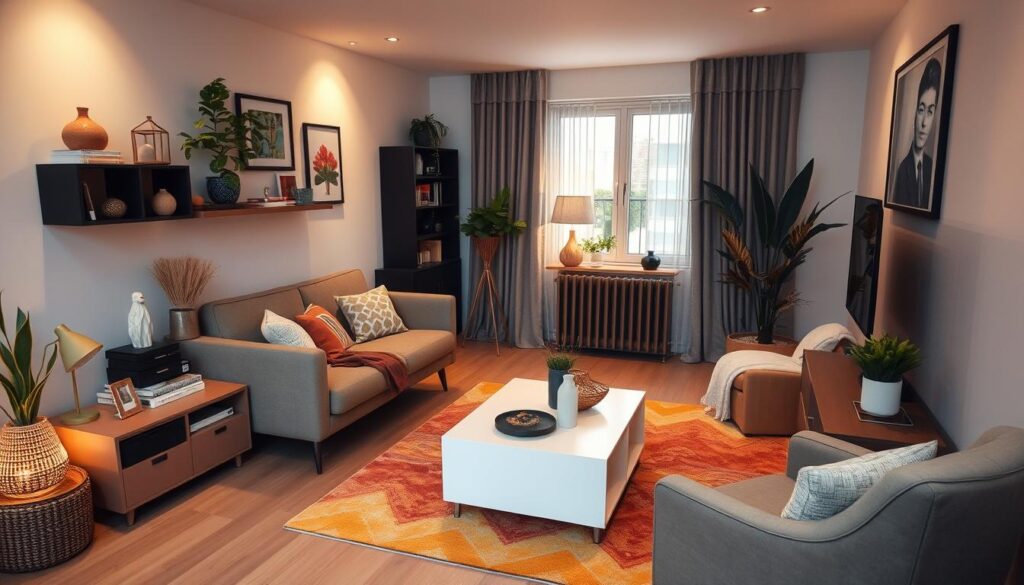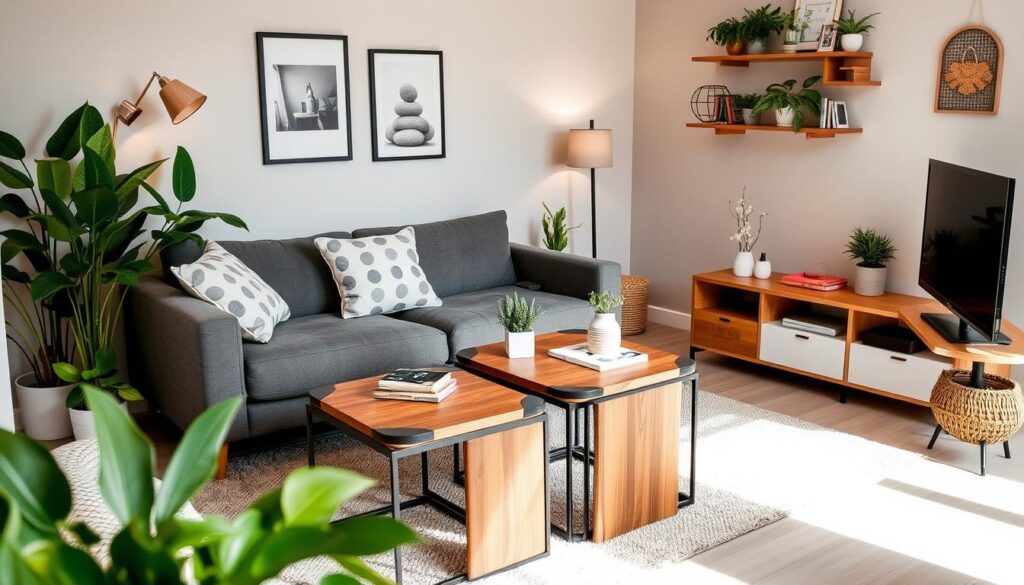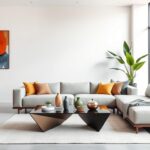We’ve all been in a small living room, wondering how to use the space well. Making the most of small spaces with furniture can be tough, but it’s also a chance to make your home stylish and useful. Every piece of furniture matters in small spaces, so planning is key to making it feel bigger.
Arranging furniture in a small room can make it seem bigger. Using neutral colors and placing furniture in the room’s center can create a cozy spot for talking. This article will give you tips and ideas to make your small space a cozy retreat. We’ll show you how to arrange furniture to make your living room or bedroom both functional and cozy.
Key Takeaways
- Coordinating furniture in small spaces requires careful planning and consideration of the room’s dimensions, traffic flow, and functional needs.
- Utilizing neutral color palettes and gathering furniture in the center of the room can create a cozy conversation area and make the space feel larger.
- Small-scale furniture and multi-functional pieces can help maximize space efficiency and create a more comfortable environment.
- Maintaining a clutter-free look and incorporating vertical décor elements can enhance the functionality and visual openness of the space.
- Learning how to coordinate furniture in small spaces can help you create a stylish and functional home that feels larger than it is.
Understanding the Basics of Small Space Design
Small space design has key principles to follow. These basics help you make a stylish and functional home, even in tight spaces. It’s important to think about the size and look of your furniture and decor. Choosing pieces that are too large or too small can make your space feel cramped or overwhelming.
Creating visual flow is another key aspect. Use space-saving furniture ideas like multi-functional pieces. Plan your room’s layout carefully to make it feel open and larger. Tips include using mirrors to reflect light and picking furniture that looks light to make space seem bigger.
Here are some more tips to remember:
- Use rugs to define different areas of your space and create a sense of unity
- Select furniture with clean lines and minimal clutter to create a sense of openness
- Consider using glass or perspex for tables and other surfaces to create a sense of transparency
By using these small space design tips and space-saving furniture ideas, you can make a beautiful and functional home, even in the smallest spaces. Always think about the size and look of your furniture and decor. Use visual flow to make your space feel open and spacious.
| Design Principle | Description |
|---|---|
| Scale and Proportion | Choosing furniture and decor that is proportional to the size of your space |
| Visual Flow | Creating a sense of openness and flow in your space through careful planning and design |
| Space-Saving Furniture | Using multi-functional pieces and other space-saving furniture ideas to maximize your space |
Measuring and Planning Your Space Like a Pro
Creating a functional and stylish small space starts with measuring and planning. Take accurate measurements of your room, including doors, windows, and other features. This helps you arrange furniture to maximize space and create a cozy living area.
To begin, use a tape measure to record your room’s dimensions. Note the width and length of each wall. Then, create a floor plan by hand or with online tools. Think about the room’s flow and where you’ll place furniture, like electrical outlets.
Here are some tips for measuring and planning your space:
- Leave at least 30 inches between furniture pieces for walkability
- Maintain 14 to 18 inches between a coffee table and sofa for accessibility
- Consider the viewing distance and angle when placing a TV, aiming for 8 to 12 feet and 30 degrees or less
By measuring and planning, you can design a small room layout that’s both functional and stylish. This way, you make the most of your space.
Don’t forget to think about furniture height and scale, and the look you want to achieve. With careful planning, you can create a beautiful and functional small space that meets your needs.
| Room Type | Minimum Walking Space | Recommended Furniture Placement |
|---|---|---|
| Living Room | 30 inches | Float furniture away from walls to create conversation areas |
| Bedroom | 24 inches | Place bed away from door and consider using tall furniture to increase volume |
| Dining Room | 36 inches | Use circular tables with pedestal bases to create a sense of flow |
Smart Furniture Selection Strategies
Choosing the right furniture is key for small spaces. Space-saving ideas can make a room more functional. With 30% of city dwellers in tiny homes, picking furniture that saves space is vital.
Look for pieces that do more than one thing. A storage ottoman can be a seat and a storage spot. A desk with shelves keeps things tidy. The right size furniture helps your space feel bigger and more open.
Think about the materials too. Furniture with exposed legs makes a room look bigger by 20%. Mirrors and shiny surfaces can make a room feel 30% larger. Some great ideas include:
- Multi-functional sofas that convert into beds
- Wall-mounted shelves and storage units
- Narrow floating shelves and desks
- Hidden storage solutions, such as under-bed storage and closet organizers
Using these ideas in your small space can make it both useful and stylish. Pick furniture that fits your space well and looks good too.
| Furniture Piece | Space-Saving Benefit |
|---|---|
| Multi-functional sofa | Saves up to 30% more space compared to traditional single-purpose pieces |
| Wall-mounted shelf | Increases storage efficiency by up to 25% in compact living areas |
| Under-bed storage | Adds up to 40% more usable space in a small bedroom |
How to Coordinate Furniture in Small Spaces: Expert Tips
Every inch matters when arranging furniture in a small living room. Use small space decorating solutions to make the most of vertical space and keep clutter down. Create a focal point, like a TV or fireplace, and arrange furniture around it. This makes the room both useful and beautiful.
Choose multi-functional furniture, like ottomans that are both a coffee table and extra seating. This reduces clutter and improves how you move around. Mirrors can also make the room seem bigger by creating depth. Experts say about 60% of small living room layouts use multi-functional furniture to save space.
Here are some key tips for arranging furniture in small spaces:
- Use lighter colors for big pieces to make the room feel bigger.
- Combine open and closed storage to cut down on clutter.
- Use vertical space to make the room seem larger.
- Make sure there are clear paths in your furniture layout for better comfort and use.
By following these expert tips, you can make a small living room both beautiful and functional. The key is to keep it simple, uncluttered, and useful.

Here’s a quick summary of the benefits of good furniture arrangement in small spaces:
| Technique | Benefit |
|---|---|
| Multi-functional furniture | Increases usable space by up to 30% |
| Vertical space utilization | Creates the illusion of a 20% larger room |
| Lighter color palette | Reflects approximately 50% more natural light |
| Clear pathways | Improves comfortability and usability by more than 30% |
By using these expert tips, you can make a small living room that’s both beautiful and functional.
Creating Zones in Limited Square Footage
We know that making zones in small spaces is key to using space well. By setting up different areas, using dividers, and keeping things looking good, we can make a space that looks great and works well. This is where small space design tips help, making the most of our small areas.
To make zones, we can use area rugs to split up spaces. We can also use space-saving furniture ideas like pieces that do more than one thing. For instance, a sofa bed can be a couch by day and a bed at night. A drop-leaf table can add dining space when needed.
Here are some good things about making zones in small spaces:
- Improved functionality: By setting up different areas for different things, we use our space better and cut down on mess.
- Enhanced style: Zones add interest to a room and make it seem bigger.
- Increased productivity: Having specific areas for work, rest, and play helps us stay on track and organized.
When we think about small space design tips and space-saving furniture ideas, we can make a space that fits our life perfectly. By using these ideas, we can create a beautiful and useful space that we’ll love for a long time.
| Zone | Function | Furniture |
|---|---|---|
| Living Area | Relaxation and entertainment | Sofa, coffee table, TV |
| Work Area | Productivity and focus | Desk, chair, computer |
| Sleeping Area | Rest and relaxation | Bed, nightstand, lamp |
Space-Saving Furniture Arrangements
In small rooms, every inch matters. To make a space both functional and stylish, pick furniture that does double duty. For instance, a storage ottoman can be a seat and a place to stash blankets and pillows.
It’s key to use furniture that saves space in small rooms. Think about wall-mounted shelves or storage units to clear floors and surfaces. This makes the room look bigger and keeps it tidy. Also, furniture with exposed legs can make a room feel more open and spacious.
Here are some tips for saving space with furniture:
- Choose multi-functional pieces, like a sofa bed or a desk with storage
- Pick furniture with a small footprint, like a nesting table or a compact chair
- Think about the room’s flow and needs when placing furniture
By using these strategies, you can arrange furniture to make the most of your small room. Always measure your space and pick furniture that fits well, leaving room to move. With some creativity and planning, you can make your small room cozy and useful.
| Furniture Piece | Space-Saving Feature |
|---|---|
| Sofa Bed | Provides a place to sit and sleep |
| Storage Ottoman | Stores items like throw blankets and pillows |
| Wall-Mounted Shelves | Keeps floors and surfaces clear |
Maximizing Vertical Space
Maximizing vertical space is key in small spaces. Use wall-mounted shelves, storage units, and cabinets to save space. This approach makes small areas feel open and functional.
Wall-Mounted Solutions
Wall-mounted items like floating shelves and desks can save a lot of space. They can free up to 30% of counter space in kitchens. Plus, they save up to 50% of floor space compared to regular furniture.
These solutions offer more storage and make rooms feel bigger. They add to the sense of openness.
Utilizing Height for Storage
Using height for storage is smart. Tall bookshelves can boost storage by about 60% compared to wide shelves. Over-the-door storage adds up to 15% more space without needing to install anything permanently.
Adding these space-saving ideas to your small space can make it more functional and open. Choose furniture that does more than one thing. Use vertical space well to maximize your small space.
Color and Pattern Coordination in Tight Spaces
Color and pattern coordination is key in small spaces. Interior designers say 75% of successful designs use no more than three colors. This creates harmony and flow in tight areas.
Mixing patterns in small spaces can be tough. 50% of homeowners find it hard, preferring simple designs. Yet, 60% of designers think mixing patterns makes a room look better. They suggest using plain cushions with patterned headboards for balance.
Some important tips for color and pattern in small spaces include:
- Choose a big pattern as a room’s focal point
- Layer patterns slowly to avoid too much
- Think about pattern sizes, using big and small wisely
By using these tips, you can make a stylish and useful space. Start with a rug to tie everything together, as 80% of designers advise.
With practice and patience, you’ll get better at color and pattern in small spaces. Don’t be scared to try new things and have fun with it!
| Design Element | Recommendation |
|---|---|
| Color Palette | Prioritize a maximum of three colors |
| Pattern Mixing | Layer patterns gradually and consider scale |
| Rug Selection | Start with a rug to ensure color and style harmony |
Lighting Strategies for Small Room Furniture Layout
Lighting is key in small spaces. It helps make rooms feel open and useful. Use light-colored curtains to let in more natural light. This simple change can greatly improve a small space, making it feel airy.
Artificial lighting is also important in small spaces. Using different light sources can create separate areas. This makes the room feel bigger by reducing shadows.
Natural Light Optimization
To get more natural light, use mirrors and shiny surfaces. They reflect light, making the room brighter. Also, light-colored walls and vertical stripes can make a room seem taller, making it feel larger.
Artificial Lighting Placement
Think about the lighting you need for each part of the room. Use task lighting for areas like reading or working. Ambient lighting adds warmth and coziness. Mixing these types of lighting makes your space both functional and welcoming.
- Using floor lamps to create a sense of height
- Incorporating table lamps to add warmth and ambiance
- Installing sconces to provide task lighting
- Utilizing string lights to create a cozy atmosphere
By using these lighting tips, you can make a small space feel bigger and more inviting. Think about what you need and try out different lighting options to find what works best for you.
Storage Solutions That Complement Your Furniture
Storage solutions are key in small spaces to keep things tidy and useful. About 60% of people in small spaces find it hard to stay clutter-free. Using furniture that saves space, like multi-functional pieces, helps a lot.
Open shelves with bins or baskets are good for sorting things. Pick storage that fits your space well. Think about how people move around and what you need in the room.
A floating bench-shelf can save floor space and offer extra storage. Tiered shelving helps clear clutter by using wall space.
Using wall space for storage is smart. Wall-mounted shelves can add up to 40% more storage. Ladder-style shelving can add about 30% more storage. Under-the-stair storage, like built-in shelves or drawers, is also a great idea.

By using these tips, you can make your small space both functional and stylish. Keep only what you really need. Closet organizers or freestanding storage can also help. With a bit of creativity, your small space can become a cozy and organized place.
Common Small Space Furniture Mistakes to Avoid
When arranging furniture in small spaces, it’s easy to make mistakes. We’ve all tried to fit too much furniture in a tiny room, ending up with a cramped space. To make a small space both functional and stylish, it’s key to avoid these errors.
One big mistake is overcrowding. This makes small rooms feel even tighter. It’s important to leave some space between furniture to keep the room inviting. Choosing furniture that serves more than one purpose helps a lot. This way, you can make your space feel open and welcoming.
Other mistakes to watch out for include:
- Using dark colors too much, which can shrink a room’s feel by 20-30%
- Not using vertical space, which limits where you can store and display things
- Choosing furniture that’s too big, which can take over the room and limit movement
To avoid these mistakes and create a beautiful small space, keep your design simple. Use light and neutral colors. And pick furniture that fits well in the room. With a bit of planning and creativity, you can make your small space cozy and inviting.
Conclusion: Creating Your Perfect Small Space Haven
Creating a perfect small space haven is all about careful planning. We need to think about the room’s size, choose the right furniture, and use vertical space well. This way, even tiny areas can become stylish and useful places to live.
It’s important to focus on scale, proportion, and how things flow in our small spaces. Using furniture that does more than one thing, and making sure there’s enough light, helps a lot. Also, setting up different areas in our homes makes them look better and feel more organized.
With smart ideas and a bit of creativity, we can make the most of our small spaces. This article has given us great tips to follow. We’re sure you’ll be able to create a beautiful and practical home that shows off your style.
FAQ
What are the key principles of small space design?
Small space design focuses on scale and proportion. It also involves creating a visual flow. Essential space planning principles are key, like choosing the right furniture size and arranging it well.
How do I measure and plan my small space effectively?
Start by taking accurate measurements and making a floor plan. Think about the room’s flow and what it needs to function. This helps pick the right furniture and arrange it to use space well.
What are some smart furniture selection strategies for small spaces?
For small spaces, choose furniture that does more than one thing. Pick furniture that fits well and materials that look good together. These tips help make your small space both useful and stylish.
How can I effectively coordinate furniture in a small living room?
Create a focal point and use vertical space in your small living room. Choose furniture that works well together. This makes your space look good and use space well.
How can I create zones in a small space?
To create zones, define areas for different activities. Use dividers to separate spaces while keeping the look smooth. This makes your small space organized and stylish.
What are some space-saving furniture arrangement tips?
Use furniture that serves more than one purpose. Choose furniture that fits right and think about how people will move. This makes your space compact but still useful.
How can I maximize vertical space in a small room?
Use wall-mounted items to save floor space. Use height for storage and add vertical design elements. This opens up your small room and makes it more functional.
What are some common small space furniture mistakes to avoid?
Avoid overcrowding and choosing furniture that’s too big. Also, don’t plan furniture placement without thinking about movement. Pick furniture that fits and makes the room easy to move around in.




